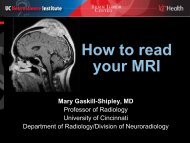tick-borne-dx-physician
tick-borne-dx-physician
tick-borne-dx-physician
Create successful ePaper yourself
Turn your PDF publications into a flip-book with our unique Google optimized e-Paper software.
14 New York City Department of Health and Mental Hygiene<br />
EHRLICHIOSIS (AKA HUMAN MONOCYTIC EHRLICHIOSIS)<br />
AGENT<br />
Bacterium: Ehrlichia chaffeensis,<br />
E. ewingii<br />
Tick: Amblyomma americanum<br />
SIGNS/SYMPTOMS<br />
[incubation period 7-14 days]<br />
• Fever, chills<br />
• Headache<br />
• Malaise<br />
• Myalgia<br />
• Gastrointestinal symptoms (nausea,<br />
vomiting, diarrhea, anorexia)<br />
• Conjunctival injection<br />
• Rash (in up to 60% of children,<br />
less than 30% of adults)<br />
• Stiff neck<br />
• Confusion<br />
Ehrlichiosis and anaplasmosis have a<br />
similar clinical presentation, but they<br />
are transmitted by 2 different species<br />
of <strong>tick</strong>s and generally occur in different<br />
regions of the U.S.<br />
LABS<br />
Common Findings on Routine<br />
Laboratory Tests<br />
Generally observed during the first<br />
week of clinical disease<br />
• Thrombocytopenia<br />
• Mild to moderate leukopenia<br />
• Modest elevations in hepatic<br />
transaminases<br />
• Mild anemia<br />
Diagnostic Laboratory Criteria<br />
• Detection of DNA by PCR assay<br />
(preferred method); or<br />
• Demonstration of a four-fold change<br />
in IgG-specific antibody titer by<br />
immunofluorescence assay (IFA) in<br />
paired serum samples; or<br />
• Immunohistochemistry (IHC) staining<br />
of organism<br />
NOTES<br />
• Confirmation of the diagnosis is based on<br />
laboratory testing, but antibiotic therapy<br />
should not be delayed in a patient with a<br />
suggestive clinical presentation.<br />
• Patients may not have a detectable<br />
antibody response during the first 7 days<br />
of illness, when most patients seek care.<br />
Consider dual testing using PCR and<br />
serologic methodologies.<br />
• Single elevated titers do not confirm a<br />
diagnosis but may merely be indicative of<br />
a past infection. To confirm a diagnosis,<br />
repeat titers 7 to 14 days later to look<br />
for a four-fold change in IgG-specific<br />
antibody titers by IFA.<br />
• Visualization of morulae in the cytoplasm<br />
of monocytes during examination of<br />
blood smears is highly suggestive of<br />
a diagnosis; however, blood smear<br />
examination is insensitive and should<br />
never be relied upon solely to rule<br />
anaplasmosis in or out.<br />
• IgM antibodies are less specific than<br />
IgG antibodies and are more likely to<br />
generate false positive results. IgM<br />
results alone should not be used for<br />
laboratory diagnosis.



